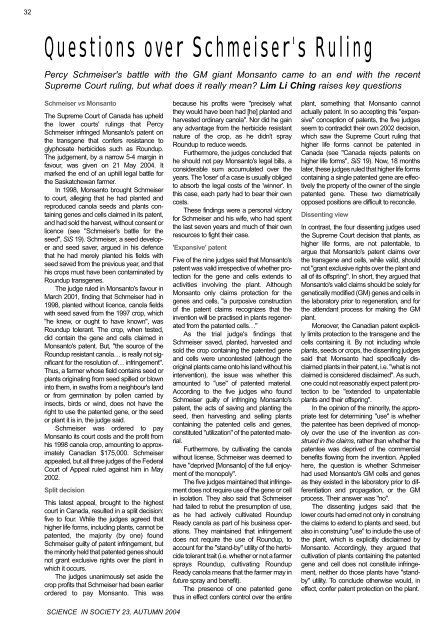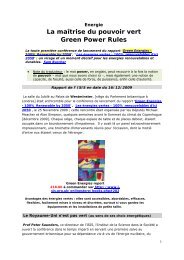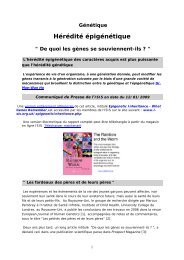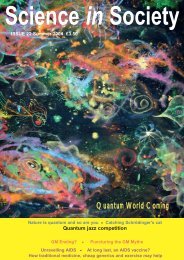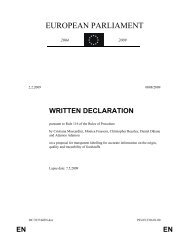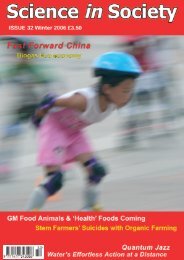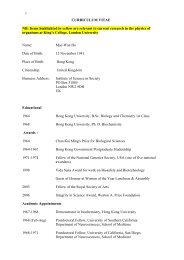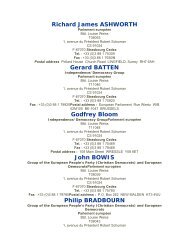Ethiopia goes organic to feed herself - The Institute of Science In ...
Ethiopia goes organic to feed herself - The Institute of Science In ...
Ethiopia goes organic to feed herself - The Institute of Science In ...
You also want an ePaper? Increase the reach of your titles
YUMPU automatically turns print PDFs into web optimized ePapers that Google loves.
32<br />
Questions over Schmeiser's Ruling<br />
Percy Schmeiser's battle with the GM giant Monsan<strong>to</strong> came <strong>to</strong> an end with the recent<br />
Supreme Court ruling, but what does it really mean? Lim Li Ching raises key questions<br />
Schmeiser vs Monsan<strong>to</strong><br />
<strong>The</strong> Supreme Court <strong>of</strong> Canada has upheld<br />
the lower courts' rulings that Percy<br />
Schmeiser infringed Monsan<strong>to</strong>'s patent on<br />
the transgene that confers resistance <strong>to</strong><br />
glyphosate herbicides such as Roundup.<br />
<strong>The</strong> judgement, by a narrow 5-4 margin in<br />
favour, was given on 21 May 2004. It<br />
marked the end <strong>of</strong> an uphill legal battle for<br />
the Saskatchewan farmer.<br />
<strong>In</strong> 1998, Monsan<strong>to</strong> brought Schmeiser<br />
<strong>to</strong> court, alleging that he had planted and<br />
reproduced canola seeds and plants containing<br />
genes and cells claimed in its patent,<br />
and had sold the harvest, without consent or<br />
licence (see "Schmeiser's battle for the<br />
seed", SiS 19). Schmeiser, a seed developer<br />
and seed saver, argued in his defence<br />
that he had merely planted his fields with<br />
seed saved from the previous year, and that<br />
his crops must have been contaminated by<br />
Roundup transgenes.<br />
<strong>The</strong> judge ruled in Monsan<strong>to</strong>'s favour in<br />
March 2001, finding that Schmeiser had in<br />
1998, planted without licence, canola fields<br />
with seed saved from the 1997 crop, which<br />
"he knew, or ought <strong>to</strong> have known", was<br />
Roundup <strong>to</strong>lerant. <strong>The</strong> crop, when tested,<br />
did contain the gene and cells claimed in<br />
Monsan<strong>to</strong>'s patent. But, "the source <strong>of</strong> the<br />
Roundup resistant canola… is really not significant<br />
for the resolution <strong>of</strong>… infringement".<br />
Thus, a farmer whose field contains seed or<br />
plants originating from seed spilled or blown<br />
in<strong>to</strong> them, in swaths from a neighbour's land<br />
or from germination by pollen carried by<br />
insects, birds or wind, does not have the<br />
right <strong>to</strong> use the patented gene, or the seed<br />
or plant it is in, the judge said.<br />
Schmeiser was ordered <strong>to</strong> pay<br />
Monsan<strong>to</strong> its court costs and the pr<strong>of</strong>it from<br />
his 1998 canola crop, amounting <strong>to</strong> approximately<br />
Canadian $175,000. Schmeiser<br />
appealed, but all three judges <strong>of</strong> the Federal<br />
Court <strong>of</strong> Appeal ruled against him in May<br />
2002.<br />
Split decision<br />
This latest appeal, brought <strong>to</strong> the highest<br />
court in Canada, resulted in a split decision:<br />
five <strong>to</strong> four. While the judges agreed that<br />
higher life forms, including plants, cannot be<br />
patented, the majority (by one) found<br />
Schmeiser guilty <strong>of</strong> patent infringement, but<br />
the minority held that patented genes should<br />
not grant exclusive rights over the plant in<br />
which it occurs.<br />
<strong>The</strong> judges unanimously set aside the<br />
crop pr<strong>of</strong>its that Schmeiser had been earlier<br />
ordered <strong>to</strong> pay Monsan<strong>to</strong>. This was<br />
because his pr<strong>of</strong>its were "precisely what<br />
they would have been had [he] planted and<br />
harvested ordinary canola". Nor did he gain<br />
any advantage from the herbicide resistant<br />
nature <strong>of</strong> the crop, as he didn't spray<br />
Roundup <strong>to</strong> reduce weeds.<br />
Furthermore, the judges concluded that<br />
he should not pay Monsan<strong>to</strong>'s legal bills, a<br />
considerable sum accumulated over the<br />
years. <strong>The</strong> 'loser' <strong>of</strong> a case is usually obliged<br />
<strong>to</strong> absorb the legal costs <strong>of</strong> the 'winner'. <strong>In</strong><br />
this case, each party had <strong>to</strong> bear their own<br />
costs.<br />
<strong>The</strong>se findings were a personal vic<strong>to</strong>ry<br />
for Schmeiser and his wife, who had spent<br />
the last seven years and much <strong>of</strong> their own<br />
resources <strong>to</strong> fight their case.<br />
'Expansive' patent<br />
Five <strong>of</strong> the nine judges said that Monsan<strong>to</strong>'s<br />
patent was valid irrespective <strong>of</strong> whether protection<br />
for the gene and cells extends <strong>to</strong><br />
activities involving the plant. Although<br />
Monsan<strong>to</strong> only claims protection for the<br />
genes and cells, "a purposive construction<br />
<strong>of</strong> the patent claims recognizes that the<br />
invention will be practised in plants regenerated<br />
from the patented cells…"<br />
As the trial judge's findings that<br />
Schmeiser saved, planted, harvested and<br />
sold the crop containing the patented gene<br />
and cells were uncontested (although the<br />
original plants came on<strong>to</strong> his land without his<br />
intervention), the issue was whether this<br />
amounted <strong>to</strong> "use" <strong>of</strong> patented material.<br />
According <strong>to</strong> the five judges who found<br />
Schmeiser guilty <strong>of</strong> infringing Monsan<strong>to</strong>'s<br />
patent, the acts <strong>of</strong> saving and planting the<br />
seed, then harvesting and selling plants<br />
containing the patented cells and genes,<br />
constituted "utilization" <strong>of</strong> the patented material.<br />
Furthermore, by cultivating the canola<br />
without license, Schmeiser was deemed <strong>to</strong><br />
have "deprived [Monsan<strong>to</strong>] <strong>of</strong> the full enjoyment<br />
<strong>of</strong> the monopoly".<br />
<strong>The</strong> five judges maintained that infringement<br />
does not require use <strong>of</strong> the gene or cell<br />
in isolation. <strong>The</strong>y also said that Schmeiser<br />
had failed <strong>to</strong> rebut the presumption <strong>of</strong> use,<br />
as he had actively cultivated Roundup<br />
Ready canola as part <strong>of</strong> his business operations.<br />
<strong>The</strong>y maintained that infringement<br />
does not require the use <strong>of</strong> Roundup, <strong>to</strong><br />
account for the "stand-by" utility <strong>of</strong> the herbicide<br />
<strong>to</strong>lerant trait (i.e. whether or not a farmer<br />
sprays Roundup, cultivating Roundup<br />
Ready canola means that the farmer may in<br />
future spray and benefit).<br />
<strong>The</strong> presence <strong>of</strong> one patented gene<br />
thus in effect confers control over the entire<br />
plant, something that Monsan<strong>to</strong> cannot<br />
actually patent. <strong>In</strong> so accepting this "expansive"<br />
conception <strong>of</strong> patents, the five judges<br />
seem <strong>to</strong> contradict their own 2002 decision,<br />
which saw the Supreme Court ruling that<br />
higher life forms cannot be patented in<br />
Canada (see "Canada rejects patents on<br />
higher life forms", SiS 19). Now, 18 months<br />
later, these judges ruled that higher life forms<br />
containing a single patented gene are effectively<br />
the property <strong>of</strong> the owner <strong>of</strong> the single<br />
patented gene. <strong>The</strong>se two diametrically<br />
opposed positions are difficult <strong>to</strong> reconcile.<br />
Dissenting view<br />
<strong>In</strong> contrast, the four dissenting judges used<br />
the Supreme Court decision that plants, as<br />
higher life forms, are not patentable, <strong>to</strong><br />
argue that Monsan<strong>to</strong>'s patent claims over<br />
the transgene and cells, while valid, should<br />
not "grant exclusive rights over the plant and<br />
all <strong>of</strong> its <strong>of</strong>fspring". <strong>In</strong> short, they argued that<br />
Monsan<strong>to</strong>'s valid claims should be solely for<br />
genetically modified (GM) genes and cells in<br />
the labora<strong>to</strong>ry prior <strong>to</strong> regeneration, and for<br />
the attendant process for making the GM<br />
plant.<br />
Moreover, the Canadian patent explicitly<br />
limits protection <strong>to</strong> the transgene and the<br />
cells containing it. By not including whole<br />
plants, seeds or crops, the dissenting judges<br />
said that Monsan<strong>to</strong> had specifically disclaimed<br />
plants in their patent, i.e. "what is not<br />
claimed is considered disclaimed". As such,<br />
one could not reasonably expect patent protection<br />
<strong>to</strong> be "extended <strong>to</strong> unpatentable<br />
plants and their <strong>of</strong>fspring".<br />
<strong>In</strong> the opinion <strong>of</strong> the minority, the appropriate<br />
test for determining "use" is whether<br />
the patentee has been deprived <strong>of</strong> monopoly<br />
over the use <strong>of</strong> the invention as construed<br />
in the claims, rather than whether the<br />
patentee was deprived <strong>of</strong> the commercial<br />
benefits flowing from the invention. Applied<br />
here, the question is whether Schmeiser<br />
had used Monsan<strong>to</strong>'s GM cells and genes<br />
as they existed in the labora<strong>to</strong>ry prior <strong>to</strong> differentiation<br />
and propagation, or the GM<br />
process. <strong>The</strong>ir answer was "no".<br />
<strong>The</strong> dissenting judges said that the<br />
lower courts had erred not only in construing<br />
the claims <strong>to</strong> extend <strong>to</strong> plants and seed, but<br />
also in construing "use" <strong>to</strong> include the use <strong>of</strong><br />
the plant, which is explicitly disclaimed by<br />
Monsan<strong>to</strong>. Accordingly, they argued that<br />
cultivation <strong>of</strong> plants containing the patented<br />
gene and cell does not constitute infringement,<br />
neither do those plants have "standby"<br />
utility. To conclude otherwise would, in<br />
effect, confer patent protection on the plant.<br />
SCIENCE IN SOCIETY 23, AUTUMN 2004


